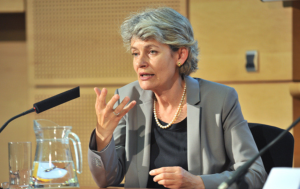View from the Snowline
Just a few days ago, I was visiting 17globalgoals.com to check out the site. It was really interesting, and I spent some serious time browsing. It certainly got me thinking.
Something however, struck me right away. It wasn’t immediately clear to me whether I was thinking about Sustainable–Development Goals, or Sustainable Development-Goals.
I know the division is not really important, and it is a little semantic, but I started to think about the sustainability component.
So firstly, who am I and why do I spend time thinking about such things? Well I have been living and working in developing countries for a number of years, most recently in Africa, and have been bound to the SDGs (as well as the Millennium Development Goals before them), when designing and developing projects.
Of course by their very nature, all development goals are top-down and theoretical, and only exist as an idea. Nevertheless, they are incorporated into operational design and measurables by project managers.
I know a little about what is good about turning SDGs into operational reality, and of course, I know a little about what is problematic. I may be back at some stage to talk a little about that.
Back to the Goals; I think that there’s an interesting discussion about what we mean by sustainability.
I have colleagues who work in the field of project hardware; infrastructure, and capital projects, such as water supplies, electrification, biogas installation etc.
Sustainability to them is often attached to renewables, low environmental impact technology, sustainable agricultural development etc, where sustainability is often directly tied to environmental impact, and otherwise means a reasonably feasible plan for functionality, for a determined period after completion of the project.
This presents a neat and reasonable timescale; a clearly defined start, middle, and end to the project, and often comes with precise, tidy, measurable performance metrics.
For colleagues and myself involved in project software, i.e. behaviour change programmes, sustainability means the ability for the programme outcomes to be functional on a permanent basis after the funder has withdrawn their support.
In reality, the outcomes need to become “the new normal.” Nobody will fund the eradication of child marriage for say, two years. They will however expect us to achieve the behaviour change permanently in three.
Performance metrics are often untidy and difficult to measure, and an end point is not clearly defined.
Treatment of symptoms is often easier to measure e.g. number of school age girls taken out of prostitution; the causes less easy, e.g. attitudes of male adults’ attitude to children (particularly girl children), treating them as property, and denying them basic human rights.
There is a huge difference in how controllable sustainability is between hardware projects and software projects. Sometimes I’m a little envious of friends who have a neat package of easy project plans and controllable budgets, reliable timelines, and a sustainable maintenance plan.
This doesn’t mean that the project delivery is easy, but it is easier to plan and report on, and consequently much more controllable.
Once the hardware project is delivered, they can move on to the next. An easy example is drilling a borehole, training a maintenance engineer, putting in place a revenue plan to fund maintenance for the life of the pump, and then moving on to the next project.
I would sometimes love that simplicity and clarity. I have been involved in a few of those types of projects, and I enjoyed the experience, without the pressures of renewing funding, and all that goes with that.
For software projects delivering behaviour change, or civil society infrastructure, there is no such simplicity, as there are two major components at play.
Number one; the environment is constantly changing, politicians, communities, and priorities are always moving. Policy-changes are frequent, as policy makers seek magic-bullet solutions (and often personal legacy), and quite often, major environmental and economic events change the situation.
For example, El Nino recently resulted in two years of drought and crop failures in the region I had been living. Food prices shot up almost immediately.
Millions of people were subject to the complete absence of food security, and aid priorities quite rightly reacted to deal with this terrible situation. The following year, the rainfall on parched lands resulted in serious floods, in which many people lost their lives.
Aid was once again (quite rightly) diverted to flood relief, disease management, and the associated food shortages. This cycle is fairly common in Southern, Eastern, and Central Africa.
An economic example of ‘uncontrollables’ would be in 2016, when the Brexit referendum result was announced; the Forex markets went into chaos. To cut a long story short, my project had the value of its funding undermined and inevitably cash flow forecasts were shot to pieces.
These factors often combine to form multipliers. An instance would be that at the same time as the Brexit instability affecting Forex, the tobacco harvest was damaged by the prevailing weather.
This also affected both Forex (”the big picture”), and food security (micro level), as many families rely on the tobacco harvest to provide their annual income.
The tobacco often provides seeds and fertilizer for them to grow maize for the coming growing season. The currency had crashed against the Dollar, and there was, for some communities, a perfect storm, a mid to long-term loss of food security.
If you are in the middle of this, carrying out for example a Gender-based Violence awareness project, or a Modern Slavery programme; you can imagine the effects of this instability on the project. Donors however, expect outcomes delivered on time.
The second major factor is the traditional three-year funding cycle. Behaviour change takes time. It needs values and beliefs to move and shift; this is notoriously difficult and time-consuming to achieve.
An example I often use is the movement on attitudes to smoking. When I was young, a lot of people smoked; in fact doctors endorsed smoking as an aid to breathing. You were considered slightly odd if you were a non-smoker.
Now attitudes have shifted 180 degrees; smokers have become to a degree, second-class citizens, as places they can freely engage in their hobby are squeezed by legislation and public opinion. This took 50 years of public campaigns, legislation, and health campaigns. That’s half a century.
Agreement on longer term funding with performance related termination options for funders could be a solution to the inbuilt instability of short term funding.
The central message is that things in developing countries are in a state of constant significant change.
This is a planning nightmare, and with funders often operating to a three year funding cycle, expecting a full sustainability plan (delivering them from the commitment to fund you), and inevitable time slippage resulting from environmental or economic events, sustainability is a dream; at least by the definitions set by funders.
If we could separate environmental sustainability from socio-economic sustainability, we would be some way forward on achieving a common language and a common understanding for the development sector.
I could write almost forever on the illusory nature of sustainability working on the ground in developing countries, but you’ll be relieved to hear that I don’t intend to.
I’m simply raising the question of what we mean by sustainability. If we can be clear whether we’re talking about Sustainable–Development Goals, or Sustainable Development-Goals, i.e. what we mean in principle, we’ll be one step closer to becoming sustainable in practice.
Image courtesy of author.





